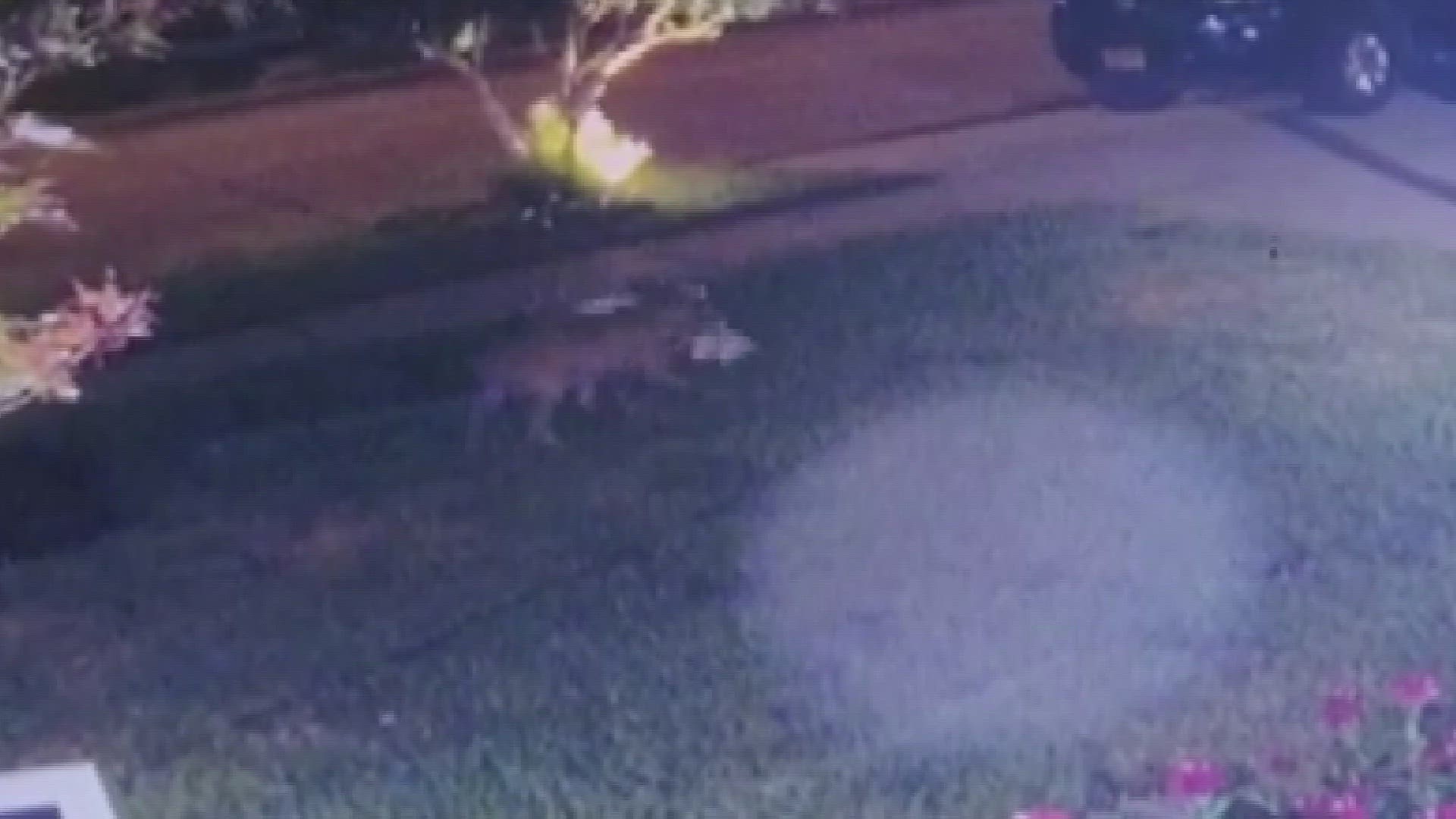METAIRIE, La. — Home surveillance video shows two coyotes on Bissonet Drive in Metairie around 3:30 a.m. Monday snatch a cat then attack and kill it.
"Coyotes just pulled it from under the car. It was two of them. They weren’t small. They ripped the animal apart and left the head and legs," said Alicia Steadman whose video captured the attack across the street.
She said her neighbor who adopted the cat keeps her second outdoor cat inside as much as possible.
"She's devastated, she's devastated. I know they were outside cats but she loved them so much," Steadman said.
Steadman's outdoor cat had a close call that night.
"They circled him, he arched his back and they went back across the street, I'm surprised," she said.
She's now trying to keep him inside at night too.
One night later on Lorino Street in Metairie, surveillance video shows several coyotes attacking ducks. The homeowner said the ducks lived behind his home and he found eight mutilated ducks scattered along his street the next morning.
"What's next, kids?" Steadman questioned. "People are worried because there have been viewings during the day in broad daylight now, they aren’t even scared of humans."
Nuisance Wildlife Control Operator Terry Friedman has been getting calls about coyotes lately.
"Floods of calls. At least eight to ten a week," Friedman said.
He's licensed by the Louisiana Department of Wildlife and Fisheries to control nuisance wildlife, including coyotes.
"The only way to get rid of these things is to euthanize them on the spot which I would do," he said.
He does not set out traps for the coyotes, so he only euthanizes them if someone spots them in person and he is able to get to them before they get away. He charges around $300.
Jefferson Parish officials said the Department of Wildlife and Fisheries is responsible in the event of a coyote sighting.
Councilman Dominick Impastato said last week the parish has gotten several calls from residents in different areas with the same complaints about the coyotes.
He said the parish reported it to animal control and the sheriff's office and both agencies said there's nothing they can do to control the animals.
"I kind of feel like that’s an excuse. I feel like something can be done," Steadman said.
The Department of Wildlife and Fisheries told us in an email that coyotes have adapted to and thrive in suburban areas. They breed once a year in January and February. The average litter size is five to seven pups.
They are born between March and May and emerge from the den two months later in May through July. They are most active at night and early in the morning but it is not uncommon to see them during daylight hours.
LDWF shared the following tips to prevent coyotes from coming to your area:
• Do NOT feed wildlife.
• Identify the problem with Game cameras
• Keep small pets indoors/do not allow pets to run loose (especially dusk and dawn); walk them on a leash
• Feed pets and store pet food indoors.
• Store garbage cans/trash bins in a garage or secure all garbage/trash bins with metal latches
1. Do not use bungee cords that can be chewed through by wildlife.
• Refrain from disposing food scraps/ leftover oil and composting
• Refrain from feeding and remove bird/squirrel feeders
1. remove the feeders for three weeks and then replace feeders.
• Secure domestic livestock, e.g. rabbits, chickens,
1. In elevated cages and/or using ¼” welded wire mesh no smaller than .9mm as foxes and coyotes can chew through smaller gauge wire or pull livestock legs, wings, etc. through mesh greater than ¼”.
2. Any caging on the ground should consist of a perimeter of welded wire mesh (no smaller than .9mm) buried into the ground and bent at a 90-degree angle to prevent wildlife from digging into the enclosure/cage.
3. Electrical fences or wire should be installed at the top (and bottom, if necessary) as well to prevent wildlife from digging or climbing into cage/enclosure.
• Install barriers around exposed decks and sheds & install electrical fencing to prevent coyote denning
• Trim all shrubs & low lying fruit tree branches & remove fallen fruit
• Use electrical fencing on garden perimeters to prevent denning
• HAZE, HAZE, HAZE*-
1. Do NOT run when you see a coyote.
2. Employ the same tactics you would with bears. Make noise, stomp your feet, make yourself look big-wave your arms, throw any items you might have near you, balls, rocks, or hose them!
3. Install automatic motion sensor sprinklers-shoots a jet of water in the direction of the animal.
4. Hazing is the MOST effective tool for preventing future encounters; however, it must be employed on a continuous basis. Let wildlife know they are not welcome.
5. When hazing wildlife be familiar with species-specific behaviors and never corner wildlife. Be certain the animal has the ability to flee. Healthy coyotes, when ‘scared’, will stall for a second, run/trot away, stall and look back and run again.
• Contact a Nuisance Wildlife Control Operator (NWCO) if you experience aggressive, fearless coyotes
► Get breaking news from your neighborhood delivered directly to you by downloading the new FREE WWL-TV News app now in the IOS App Store or Google Play.

